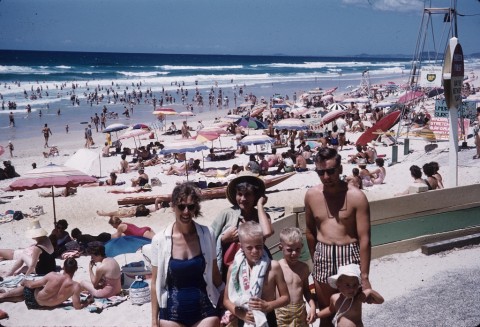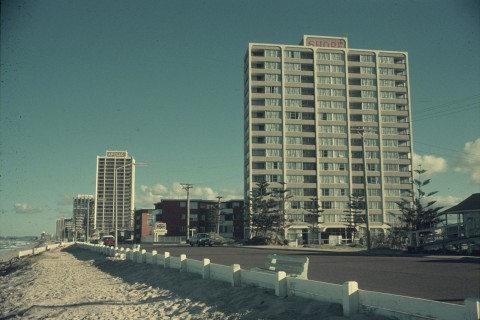Surfers Paradise, a coastal resort 75 km south of central Brisbane, is the best-known of the settlements on the Gold Coast. It includes the canal suburbs of Isle of Capri, Paradise Island, Paradise Waters and Chevron Island. Since the 1950s Surfers Paradise has entered the Australian imagination as the ultimate beach resort. It continues to have fans and detractors. Today it is an hour's drive from Brisbane, and a 30 minute drive to Coolangatta airport for flights to southern capitals.
The Nerang River flows northwards, parallel to the beach, creating a narrow coastal strip on which Surfers Paradise was originally created. Further north is Southport, a township established about 50 years before the Surfers Paradise Hotel was built in 1925. The Nerang River passed through unpromising swamp, estuarine plains and tidal marshes, leaving only recent foreshore dunes and older dunes mixed with organic matter as habitable land.
EARLY EUROPEAN SETTLEMENT
In 1865 two timber-getters tried cotton growing near the then unnamed locality, and erected an inn for coastal wayfarers. Twelve years later they disposed of their interests to Johann Meyer, a sugar cane grower, who also operated a ferry across the Nerang River to a wharf at the end of the present day Cavill Avenue, formerly Ferry Road, which established the centrepoint of Surfers Paradise's subsequent business district. The ferry also served the Southport to Coolangatta coach route, and Meyer built a hotel on the beach road. The locality across from Meyer's ferry was known as Elston.
During the 1880s railway lines were opened to seaside swimming places such as Sandgate (1882) and Southport (1889), prompted by or prompting land subdivisions for holiday houses and investors. By 1915 the subdivisional activity had moved down from Southport estate immediately north of Ferry Road (Cavill Avenue), extending from the river to the beach esplanade. In 1917 the Surfers Paradise Estate was put up for sale, north of First Street, Broadbeach. Two years later a general store, refreshment room and camping ground were opened on the future site of the Chevron Hotel, a block north of Ferry Road.
FROM ELSTON TO SURFERS' PARADISE
The event that marked the beginning of Surfers Paradise was the building of Jim Cavill's Surfers Paradise Hotel in Ferry Road in 1925, a year after the formation of a progress association and coinciding with the opening of the Jubilee Bridge across the Nerang River. The two storey, mock Tudor hotel was well appointed, with 16 rooms, and it attracted increasing numbers of motorists and beach trippers. A surf life-saving club was established in 1926, well supported by Cavill who saw that it enhanced the patronage of his hotel.
The official place name was changed from Elston to Surfers Paradise in 1933. The beach had relaxed dress standards: the neck-to-thigh bathing suit by-law was weakly enforced from over the river at Southport, and in the late 1930s the Melbourne fashion one-piece suit made its way northwards by winter vacationers. There was also considerable building activity, as affordable fibro holiday shacks were erected during the great Depression. By 1937 there were about 500 houses and holiday flats, along with a primary school and Catholic church (1934) and a picture theatre (1937). A State primary school was opened in Laycock Street, three blocks south of Cavill Avenue, in 1934. It was replaced with a new site on the Isle of Capri in 1976.
Regular flights from Sydney and Melbourne to Coolangatta airport began in 1947. The Surfers Paradise Chamber of Commerce was established in 1947, but building and development was hampered by scarce materials being directed to meet residential shortages in preference to holiday places. By the mid-1950s Surfers Paradise (as described by local historian Alex McRobbie) was 'a rather ugly conglomeration of mostly badly-designed buildings with a heavy emphasis on unpainted fibro, corrugated iron roofing, smelly septic systems, un-made roads and inadequate drainage, a great place to live when the weather was fine, but not much fun during long periods of rain'.
TOURIST RESORT
Surfers Paradise came to the forefront of beach fashion when in the early 1950s a local retailer, Paula Stafford, had six models parade her two-piece French swim suits on the beach, attracting press photographers and newsreel cameras. Surfers Paradise became identified with the bikini, an association later capitalised on by the Chamber of Commerce with its Meter Maids who fed coins into council parking meters to keep tourists and shoppers in the town.
The relaxed standards attracted visiting celebrities to Surfers Paradise (Laurence Olivier and Vivien Leigh, 1948, Audrey Hepburn and Lauren Bacall), usually to be seen at the Windjammer restaurant. As building materials became more plentiful accommodation standards moved in the 1950s from the old-fashioned fully-catered boarding or guest houses to self-catering apartments with swimming pools, telephones and bed lamps that worked. These innovations coincided with longer shopping hours and women were being wooed by a major fashion parade with leading models. Businesses grew, with seven banks in Surfers Paradise opening between 1953 and 1957.
MOTELS, CANALS AND UNITS
American style motels, such as the El Dorado (1955), provided further advances in accommodation, while in out-of-town Broadbeach Lennons opened a multi-storey hotel atop sand-mined dunes in 1956. In the heart of Surfers Paradise, Stanley Korman opened the first stage of his Chevron Hotel development, an international standard hotel, overshadowing the aged Cavill's hotel and ultimately buying it out. The first of many canal estates, Florida Gardens, was begun at the back of Broadbeach, and by the end of the 1950s works were in hand for canal estates at Paradise Island (also a Korman project). The credit squeeze (1961) removed Korman from the scene but by 1963 the finance companies which acquired the Chevron development presided over Surfers' largest employer (600 staff). Korman is nevertheless recognised as the person who put Surfers Paradise on the map.
The Surfers Paradise canal estates were the template for the many others that followed. Goat Island, a land-linked sand mass west of Elkhorn Avenue, was recontoured by sand pumping and renamed Chevron Island, another Korman project. MacIntosh Island to the north was similarly engineered and marketed by Bruce Small and the Hooker Rex company. Named Paradise Waters, it became the address of some of the Gold Coast's costliest real estate. South of Chevron Island the Gooding family had run a sugar cane farm and dairy on swampy farmland. The site was acquired for development in 1958 and onsold to Bruce Small who subdivided the recontoured 100 acres and sold them as the Isle of Capri in the early 1960s.
Apartments moved to high-rise with the Kinkabool 11 storey development (1960), and by 1971 another 11 apartment projects were completed, the highest, Apollo and Iluka, reaching 20 storeys. The consummation of the apartments boom came during 1979-82, fuelled by optimistic southern investors who soon found themselves in the midst of a severe downturn in market values. The Home Units Building Act (1965) boosted the apartments market, making it easier for investors and owner-occupiers to get a mortgage from the banks on the basis of strata title.
Surfers Paradise was publicised by its huckster mayor, Bruce Small (elected 1967), and attracted unwanted attention when king tides washed away much of the beach in June 1967. The race to build a protective wall was national news, accompanied by pictures of apartment blocks with exposed foundations.
SHOPPING
Retailing in Surfers Paradise, which offered Melbourne-style intimacy, suffered from the opening of drive-in shopping centres at Sundale, Southport (1969) and Pacific Fair, Broadbeach (1977). Cavill Avenue was made a pedestrian mall in 1976. Shopping then shifted from everyday things to fashion, and in 1987 nearly half the 400 shops in Surfers Paradise stocked fashion and accessories. Several were hotel lobbies or gallerias. By then there were no greenfield sites in Surfers for major retail projects. Jupiters Casino, across Hooker Boulevard from Pacific Fair, opened in 1985.
Several international hotels quickly followed: Conrad Hilton (622 rooms, 1985), Ramada (replacing Jim Cavill's hotel, 406 rooms, 1985), Holiday Inn (108 rooms, 1986), Christopher Skase's Sheraton Mirage (Main Beach, The Spit, 300 rooms, 1987) and Sea World Nara Resort (1988). Lennons Broadbeach hotel was demolished and redeveloped in 1989, with accommodation and a shopping resort. The Chevron site was redeveloped by Jim Raptis, who lost control of the site in the financial collapse of 2009.
Schoolies Week, where final year high school students head for the coast, began at Broadbeach in the 1970s. Surfers Paradise quickly became the centre of Australia's largest and most elaborately organised Schoolies Week, attracting thousands from Queensland, New South Wales and Victoria.
Ever since Bernard Elsey started pyjama parties at his Beachcomber Hotel in 1957 and lent his receptionist to be the first bikini-clad Meter Maid in 1965, Elsey and his promotions have typified Surfers Paradise. The sand and surf are acknowledged to be better down the coast, but Surfers shopping, nightlife and theme parks are supposedly second to none. The original appeal of Surfers Paradise - pleasant temperatures, hours of sunshine and a long beach - brought fibro holiday houses and permanent residents, but many residents have since retreated to waterfront estates west of the Nerang River. They have travelled a circle, back to places like the calmer waters of Broadwater which drew holiday-makers to Southport in the 1890s.
The median age of Surfers Paradise residents in 2011 was 36, the same as Queensland as a whole. Surfers Paradise has a shopping and civic centre, a bowling club, five churches and two synagogues. Younger and fitter residents also have the Northcliffe (1947) and Surfers Paradise surf live-saving clubs.
In July 2014 Surfers Paradise was linked along the 13-kilometre light rail corridor between the Gold Coast University Hospital and Broadbeach South.
Surfers Paradise census populations have been:
| Census Date | Population | Population including visitors |
|---|---|---|
| 1954 | 2402 | - |
| 1961 | 4319 | - |
| 1968 | - | 19,069 |
| 1996 | - | 24,086 |
| 2001 | - | 30,416 |
| 2006 | 18,501 | - |
| 2011 | 19,668 | - |
Michael A. Jones, A sunny place for shady people: the real Gold Coast story, Sydney, Allen & Unwin, 1986
Alexander McRobbie, 20th Century Gold Coast people, Surfers Paradise, Gold Coast Arts Centre Press, 2000
Alexander McRobbie, The fabulous Gold Coast, Surfers Paradise, Pan News, 1984
Alexander McRobbie, The real Surfers Paradise: from seaside village to international resort, Surfers Paradise, Pan News, 1988
Russell A. Smith, Beach resorts: a model of devleopment evolution, University Microfilms International, Harvard Graduate School of Design, 1990
John Vader, The Gold Coast book: an illustrated history, Milton, Jacaranda Press, 1980




















































































